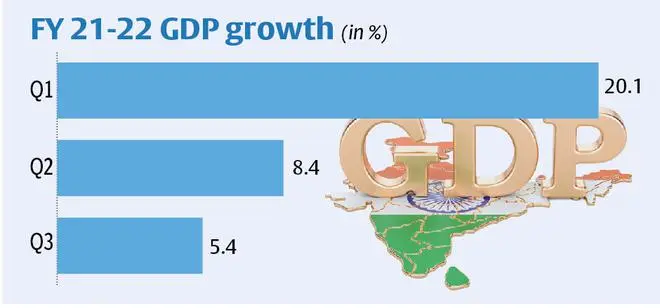Reflecting economic recovery, the country’s real GDP growth for 2021-22 is projected at 8.9 per cent in contrast with the contraction of 6.6 per cent recorded in 2020-21. The National Statistics Office (NSO)‘s second advance estimate for national income released on Monday projected the nominal GDP growth for 2021-22 at 19.4 per cent.
Even at the second advance estimate projected growth level of 8.9 per cent, India will be among the fastest growing large economies of the world. The NSO had, as part of the first advance estimate for 2021-22 released on January 7, pegged the GDP growth at 9.2 per cent. The RBI had projected 9.2 per cent GDP growth for 2021-22.

Omicron impact
The downside was a drag in manufacturing output and some impact of omicron variant in contact-intensive sectors. Manufacturing showed a low growth in Q3 of just 0.2 per cent even though corporates have established healthy growth in profit. The government sector was the main driver in Q3 as the expenditure targets are to be met.
Madan Sabnavis, Chief Economist, Bank of Baroda, said the GDP growth numbers for FY22 are on track and consistent with the first estimate for FY22 and the revised estimates for FY21. “At 8.9 per cent, it does indicate that growth can be taken to be established for the year. However, the implicit message is that Q4 will witness a slowdown which will be around 4.8 per cent. the Omicron effect is responsible for this,” he said.
India’s economy is currently growing slightly slower than previously forecast after the latest wave of coronavirus slowed economic activity and a rise in commodity prices — especially with global crude oil at about $105 per barrel—amid Russia’s invasion of Ukraine. Rising crude oil prices and supply disruptions on account of geopolitical situation could further slow down the economy posing risks to household spending and private investments, economy watchers said.
Q3 GDP rises
Meanwhile, the third quarter GDP growth for the current fiscal stood at 5.4 per cent as compared to 0.7 per cent in same quarter last fiscal. The latest third quarter GDP growth of 5.4 per cent was lower than the 8.4 per cent growth (which crossed pre-pandemic levels) seen in second quarter this fiscal and 20.1 per cent growth in the first quarter this fiscal, official data showed.
Related Stories
Moody’s raises growth projection for India in calendar 2022 to 9.5 per cent
For Fiscal Year 2022-23 growth estimate is 8.4 per cent, Fitch projects growth at 10.3 per centAditi Nayar, Chief Economist, ICRA, said the most encouraging piece of the dis-aggregated GDP data is the 7 per cent expansion in private consumption in Q3 FY2022, which, coupled with the mild rise in current consumer confidence in January 2022 despite the onset of the third wave, bodes well for the outlook for demand and capacity utilisation. “However, the feeble 2.0 per cent YoY rise in gross fixed capital formation was the biggest disappointment, reiterating the tentativeness of the investment cycle,” she said.
Core sector improves
The eight core industries’ output grew 3.7 per cent in January 2022, higher than 1.3 per cent in same month last year. The latest core industries print was lower than 4.1 per cent in December 2021, official data released on Monday showed.
The government has also now revised the core sector growth for October 2021 to 8.7 per cent.
The Centre said that core industries’ output for April-January 2022 grew 11.6 per cent as compared to contraction of 8.6 per cent in the same period in the previous fiscal.
In January 2022, six of the eight core industries recorded output growth on a year-on-year basis. Only crude oil and fertilisers recorded contraction at 2.4 per cent and 2 per cent respectively.
The sectors that saw positive growth are coal (8.2 per cent); natural gas (11.7 per cent); refinery products (3.7 per cent): steel (2.8 per cent); cement (13.6 per cent) and electricity (0.5 per cent).
Stable fiscal position
Aided by a strong show on both tax revenues and non-tax revenues, the Centre’s fiscal deficit for the first ten months came in at ₹ 9.37 lakh crore, which is 58.9 per cent of the revised budget level of ₹15.91-lakh crore for 2021-22.
At the same stage last fiscal, the Centre’s fiscal deficit as a percentage of revised estimate was 66.8 per cent, the latest data from Controller General of Accounts (CGA) showed.
In April-December 2021, the Centre’s fiscal deficit stood at ₹7.59 lakh-crore, which is 50.4 per cent of the budgeted fiscal deficit of ₹15.06-lakh crore.




Comments
Comments have to be in English, and in full sentences. They cannot be abusive or personal. Please abide by our community guidelines for posting your comments.
We have migrated to a new commenting platform. If you are already a registered user of TheHindu Businessline and logged in, you may continue to engage with our articles. If you do not have an account please register and login to post comments. Users can access their older comments by logging into their accounts on Vuukle.